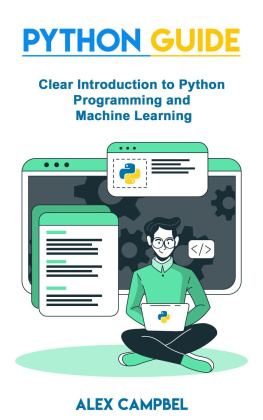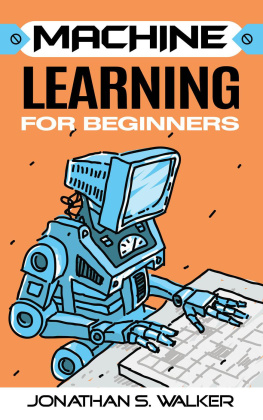Python Machine Learning
A Step-by-Step Guide to Scikit-Learn and TensorFlow (Includes a Python Programming Crash Course)
Copyright 2019
All rights reserved. No part of this book may be reproduced or used in any manner (electronic or mechanical, including photocopying, recording, physical and online storage) without written permission of the publisher or the author except for the use of quotations in a book review.
All efforts have been executed to provide complete and useful information, but no implicit or explicit warranties are provided about the information included. The content will not replace the consultation of a licensed professional.
Table of Contents
Introduction
Congratulations on buying Python Machine Learning and thank you for doing so.
The following chapters will discuss the things that you need to know to take machine learning and use it in your business or on your next project. And when you combine the different ideas that come with machine learning, and some of the different algorithms, with the Python coding language and the different libraries that come with it, you will find that it is possible to really get some of the complicated tasks done with ease.
This guidebook is going to start out with a good introduction to machine learning to help us understand what it is about, some of the options that you can do with machine learning as a beginner, the reasons to use or even learn about machine learning, and how machine learning and artificial intelligence are the same and how they are different. This gives us a general introduction to what this process is about and how we will be able to use it as we progress through this guidebook.
From there, we are going to explore a bit about the Python language with a crash course in coding in this language. For those who have never been able to learn Python, or who want to jump right into machine learning without all of the studying of a new language along the way, this part is the one for you. We are going to look at some topics like what Python is and how to download it on the different operating systems out there, how to write conditional statements, how to raise and manage your own exceptions, the OOP and functions, and even some of the other basic parts of a Python code.
In the third section of this guidebook, we are going to take a look at our very first Python library and what you can do with it when it comes to machine learning. We will explore a bit about Scikit-Learn and what this library can do, before diving into some of the supervised and unsupervised machine learning that you are able to do with this kind of library.
To finish out this guidebook, we are going to explore our second Python library of TensorFlow. There are some neat things that you can do with machine learning when it comes to TensorFlow that you are not able to do with any other coding library, so it is definitely a section you will want to check out. Inside we are going to explore the TensorFlow library, how to work with High level and low-level APIs, and how to handle estimators.
There is so much that you can do when we talk about machine learning, and the Python coding language makes it that much easier for everyone to get started. when you are ready to learn more about Python machine learning and how to get started with some of your own projects today, make sure to check out this guidebook to help you out!
Part 1: An Introduction to Machine Learning
Chapter 1: What is Machine Learning
The first topic that we need to take a look at in this guidebook is machine learning. This is basically a process where you are trying to teach a computer or another machine how to use its own experiences with a particular user, and some of the things it has seen in the past, to help it perform even better in the future. There are a lot of examples of how this can work, such as voice recognition devices, and even with search engines.
As we go through this guidebook, you will find that there are a lot of different methods and algorithms that you can use with machine learning in order to get the machine to learn, but the one you choose really depends on the kind of results you want to get and the project that you decide to work with.
Machine learning is going to be a method of data analysis that is able to automate the process of building analytical models. It is also a branch of artificial intelligence that is going to be based on the whole idea that a system is able to learn from the data it is presented, it can identify the patterns that are there, and it is even able to make its own decisions without a lot of intervention from humans in the process.
Because of all the new computing technologies that are out there, machine learning, as we know it today, is not really the same as the machine learning that we see in the past. It was born out of a form recognition for patterns and the idea of how a computer is able to actually learn, without a programmer there, to ensure it performs a task specifically. Researchers who were interested in some of the things that we are able to do with artificial intelligence wanted to also see if their machines were able to learn from data that it was fed.
The iterative aspect that comes with this machine learning should be seen as an important programming tool because as we expose any of the models we create from this learning to new data, the model is then able to adapt on their own and independently. The machine is going to be able to learn what has happened to it in the past, and the examples it was given, in order to make accurate and reliable predictions in the future.
In recent years, there has been a resurgence in the amount of interest that is out there with machine learning thanks to a few different factors. In particular, some things like Bayesian analysis and data mining are growing in popularity as well, and in the process, machine learning is going to be used more now than ever before.
All of these things mean that it is now easier and faster in order to automatically produce models with machine learning. And these models are now able to analyze bigger and more complex data, while also delivering results faster and results that are more accurate, even when this is done on a very large scale. And because all of this is able to come together and build models that are more precise, and organization is going to set itself up for identifying profitable opportunities better than before, while also avoiding more of those unknown risks ahead of time. This all comes together to help a company to become more competitive in the market.
There are a few things that need to come together in order to make sure that the system you use in machine learning is actually good. Some of these will include:
Ensemble modeling
Scalability
Iterative and automation processes
Algorithms, a good combination of basic and advanced ones
Data preparation capabilities.
The neat thing about working with machine learning is that almost every industry is able to use it. And it is still relatively new when it comes to the world of technology, so even the amazing things that have been done with it so far is just the beginning, and it is believed that this kind of technology is going to be able to do even more things in the process.
Machine learning is likely to grow quite a bit as time goes on. Right now, a lot of companies are using it in order to figure out what the data they are receiving is telling them, to figure out how they are able to make better business decisions over time, rather than having to make the decisions on their own, and to find some of the patterns that are hidden in the data, and that a human would not be able to go through.




